
There are over 9,000 Grade I listed buildings in England. This page is a list of these buildings in the City of Westminster.

There are over 9,000 Grade I listed buildings in England. This page is a list of these buildings in the City of Westminster.
| Name | Location | Type | Architect | Completed [note 1] | Date designated | Grid ref. [note 2] Geo-coordinates | Entry number [note 3] | Image |
|---|---|---|---|---|---|---|---|---|
| New West End Synagogue | St. Petersburgh Place W2 | Synagogue | George Ashdown Audsley (with Nathan S. Joseph) | 1877–1879 | 27 Jun 1975 | TQ2568580683 51°30′40″N0°11′25″W / 51.511104°N 0.190247°W | 1264769 |  |
| St Sophia's Cathedral and presbytery | Moscow Road W2 | Greek Orthodox cathedral | John Oldrid Scott | 1878–79 | 1 Dec 1987 | TQ2557480836 51°30′45″N0°11′30″W / 51.512504°N 0.191791°W | 1223553 |  |
| Name | Location | Type | Architect | Completed [note 1] | Date designated | Grid ref. [note 2] Geo-coordinates | Entry number [note 3] | Image |
|---|---|---|---|---|---|---|---|---|
| Equestrian statue of Charles I | Charing Cross SW1 | Equestrian statue | Hubert Le Sueur (sculptor) | 1633 | 9 Jan 1970 | TQ3003780373 51°30′26″N0°07′40″W / 51.507334°N 0.127684°W | 1357291 |  |
| Statue of James II | Trafalgar Square WC2 | Statue | Peter van Dievoet and Laurens van der Meulen (sculptors) Grinling Gibbons (workshop) | 1686 | 5 Feb 1970 | TQ2994080498 51°30′31″N0°07′45″W / 51.50848°N 0.129035°W | 1217629 |  |
| St Martin-in-the-Fields | Trafalgar Square WC2 | Parish church | James Gibbs | 1722–1726 | 24 Feb 1958 | TQ3010280541 51°30′32″N0°07′36″W / 51.508829°N 0.126686°W | 1217661 |  |
| Churchyard walls and railings surrounding St Martin in the Fields on North, South, East and West Sides | Trafalgar Square WC2 | Wall | James Gibbs | c. 1726 | 1 Dec 1987 | TQ3011880567 51°30′33″N0°07′35″W / 51.509059°N 0.126446°W | 1066237 |  |
| National Gallery | Trafalgar Square WC2 | Public art gallery | William Wilkins (extended by Edward Middleton Barry, Sir John Taylor and others) | 1832–1838 | 5 Feb 1970 | TQ2996180544 51°30′32″N0°07′43″W / 51.508888°N 0.128715°W | 1066236 | 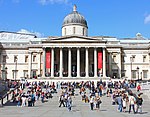 |
| Nelson's Column | Trafalgar Square WC2 | Column | William Railton (statue of Nelson by Edward Hodges Baily ; lions by Sir Edwin Landseer) | 1839–1842 | 5 Feb 1970 | TQ3001780419 51°30′28″N0°07′41″W / 51.507752°N 0.127955°W | 1276052 |  |
| Admiralty Arch, First Sea Lord's Residence and Offices, Balustrades and Steps | Charing Cross SW1 | Apartment | Sir Aston Webb | 1906–1911 | 5 Feb 1970 | TQ2997080305 51°30′24″N0°07′43″W / 51.506739°N 0.128674°W | 1238982 |  |
| Sainsbury Wing at the National Gallery | Trafalgar Square WC2 | Public art gallery | Robert Venturi , Denise Scott Brown and Associates | 1988–1991 | 9 May 2018 | TQ2988580510 51°30′31″N0°07′47″W / 51.50857°N 0.12978°W | 1451082 |  |
| Edith Cavell Memorial | St Martin's Place WC2 | Statue | George Frampton | 1920 | 5 Feb 1970 | TQ2995380649 51°30′34″N0°07′38″W / 51.509324°N 0.127183°W | 1264768 |  |
| Name | Location | Type | Architect | Completed [note 1] | Date designated | Grid ref. [note 2] Geo-coordinates | Entry number [note 3] | Image |
|---|---|---|---|---|---|---|---|---|
| St Paul's, Covent Garden | Covent Garden Piazza / Bedford Street WC2 | Parish church | Inigo Jones (restored by Thomas Hardwick and altered by Henry Clutton ) | 1631–1638 | 24 Feb 1958 | TQ3030080849 51°30′42″N0°07′25″W / 51.511551°N 0.123721°W | 1066487 |  |
| Theatre Royal, Drury Lane and attached Sir Augustus Harris Memorial Drinking Fountain | Catherine Street / Drury Lane WC2 | Theatre and drinking fountain | Benjamin Dean Wyatt (additions and alterations by Samuel Beazley and others) | 1811–1812 | 24 Feb 1958 | TQ3053781017 51°30′47″N0°07′13″W / 51.513006°N 0.120245°W | 1357276 | 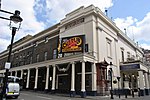 |
| Royal Opera House | Bow Street / Floral Street WC2 | Opera house | Edward Middleton Barry | 1857–1858 | 9 Jan 1970 | TQ3036281019 51°30′47″N0°07′22″W / 51.513065°N 0.122765°W | 1066392 | 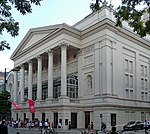 |
| Name | Location | Type | Architect | Completed [note 1] | Date designated | Grid ref. [note 2] Geo-coordinates | Entry number [note 3] | Image |
|---|---|---|---|---|---|---|---|---|
| Albert Memorial | Kensington Gore SW7 | Commemorative monument | Sir George Gilbert Scott | 1862–75 | 14 Jan 1970 | TQ2657879738 51°30′09″N0°10′40″W / 51.502412°N 0.177725°W | 1217741 |  |
| Royal Albert Hall | Kensington Gore SW7 | Public hall | Francis Fowke (completed by Henry Young Darracott Scott) | 1867–71 | 24 Feb 1958 | TQ2660279585 51°30′04″N0°10′39″W / 51.501032°N 0.177434°W | 1217742 |  |
| Holy Trinity Church | Prince Consort Road SW7 | Church | George Frederick Bodley | 1901–7 | 24 Feb 1958 | TQ2650579467 51°30′00″N0°10′44″W / 51.499993°N 0.178873°W | 1265499 |  |
| Name | Location | Type | Architect | Completed [note 1] | Date designated | Grid ref. [note 2] Geo-coordinates | Entry number [note 3] | Image |
|---|---|---|---|---|---|---|---|---|
| St Augustine's Church | Kilburn Park Road NW8 | Church | John Loughborough Pearson | 1870–7 | 25 Sep 1951 | TQ2553083130 51°31′59″N0°11′30″W / 51.533129°N 0.191609°W | 1221320 |  |
| Name | Location | Type | Architect | Completed [note 1] | Date designated | Grid ref. [note 2] Geo-coordinates | Entry number [note 3] | Image |
|---|---|---|---|---|---|---|---|---|
| Catholic Apostolic Church and Church House | Maida Avenue W2 | Irvingite church and adjoining caretaker's house | John Loughborough Pearson | 1891–3 | 5 Feb 1970 | TQ2645282020 51°31′23″N0°10′43″W / 51.522948°N 0.178721°W | 1238911 | 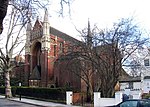 |
| Name | Location | Type | Architect | Completed [note 1] | Date designated | Grid ref. [note 2] Geo-coordinates | Entry number [note 3] | Image |
|---|---|---|---|---|---|---|---|---|
| 31 Old Burlington Street | 31 Old Burlington Street, Mayfair, W1S 3AS | Terraced town house | Colen Campbell | 1718–24 | 24 Feb 1958 | TQ2912280674 51°30′37″N0°08′27″W / 51.510249°N 0.14075°W | 1225471 |  |
| St George's, Hanover Square | Hanover Square W1 | Parish church | John James | 1720–4 | 24 Feb 1958 | TQ2897380927 51°30′45″N0°08′34″W / 51.512556°N 0.142804°W | 1235638 |  |
| George Frideric Handel's house | 25 Brook Street, W1K 4HB | Terraced house | — | c. 1725 | 24 Feb 1958 | TQ2875580967 51°30′47″N0°08′45″W / 51.512966°N 0.145929°W | 1066382 |  |
| Grosvenor Estate Office | 66 Brook Street and 53 Davies Street, Mayfair, W1K 5JH | Terraced town house | Edward Shepherd (No. 66); Thomas Cundy (No. 53) | c. 1725–30 (No. 66); 1820s–30s (No. 53) | 24 Feb 1958 | TQ2856680954 51°30′46″N0°08′55″W / 51.512892°N 0.148656°W | 1219812 |  |
| 44 Berkeley Square | 44 Berkeley Square, Mayfair, W1 | Terraced town house | William Kent | 1742–44 | 24 Feb 1958 | TQ2871480555 51°30′33″N0°08′48″W / 51.509272°N 0.14667°W | 1066466 |  |
| 45 and 46 Berkeley Square | Berkeley Square W1 | Terraced town houses, 46 is home to Annabel's private member's club | Henry Flitcroft (No. 45; no. 46 attributed to him) | c. 1744–50 | 24 Feb 1958 | TQ2872080548 51°30′33″N0°08′48″W / 51.509208°N 0.146586°W | 1218401 | 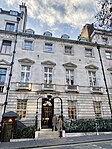 |
| 17 Hill Street | Hill Street W1 | Terraced town house | Benjamin Timbrell; additions and alterations by Robert Adam | 1748–9; 1777–9 | 24 Feb 1958 | TQ2862380490 51°30′31″N0°08′53″W / 51.508709°N 0.148004°W | 1066622 |  |
| Royal Institution | 21 Albemarle Street W1 | Headquarters converted from terraced town house | Thomas Webster (1799); Lewis Vulliamy (façade, 1838) | 1756; 1799; 1838 | 24 Feb 1958 | TQ2900480621 51°30′35″N0°08′33″W / 51.509799°N 0.142469°W | 1066521 |  |
| Cambridge House | 94 Piccadilly and 12 White Horse Street W1 | Town mansion | Matthew Brettingham | 1756–60 | 24 Feb 1958 | TQ2881680190 51°30′21″N0°08′43″W / 51.505969°N 0.145334°W | 1226748 | 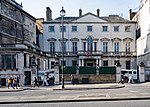 |
| 3–6 Grafton Street with 10 Bruton Lane | Grafton Street W1 | Terraced town houses | Sir Robert Taylor | c. 1760–72 | 24 Feb 1958 | TQ2891180604 51°30′35″N0°08′38″W / 51.509668°N 0.143815°W | 1289151 |  |
| 10 Hertford Street | Hertford Street W1 | Terraced town house | Henry Holland Sr. and Henry Holland Jr.; interior by Robert Adam | c. 1768–9; interior 1769–71 | 24 Feb 1958 | TQ2863980148 51°30′20″N0°08′52″W / 51.505632°N 0.147898°W | 1230913 |  |
| Crockford's | 30 Curzon Street W1 | Terraced town house | Robert Adam (interior) | 1771 | 24 Feb 1958 | TQ2855580236 51°30′23″N0°08′57″W / 51.506442°N 0.149076°W | 1356991 |  |
| Melbourne House | Albany W1 | Town mansion | Sir William Chambers; altered by Henry Holland (Jr.) | 1771–6; 1802–3 | 24 Feb 1958 | TQ2926380548 51°30′33″N0°08′20″W / 51.509084°N 0.138766°W | 1357178 |  |
| Albany Courtyard | 1–6 Albany W1 | Flanking forecourt wings of town mansion | Sir William Chambers | 1771–6 | 24 Feb 1958 | TQ2927480520 51°30′32″N0°08′19″W / 51.50883°N 0.138618°W | 1209755 |  |
| Ely House | 37 Dover Street W1 | Terraced town house | Sir Robert Taylor | 1772 | 24 Feb 1958 | TQ2899880474 51°30′31″N0°08′33″W / 51.50848°N 0.142609°W | 1066901 |  |
| Part of the Royal Institution | 20 Albemarle Street W1 | Terraced house | — | Late 18th century; remodelled internally early and late 19th century | 9 Jan 1970 | TQ2902380601 51°30′35″N0°08′32″W / 51.509615°N 0.142203°W | 1066520 |  |
| Bodley House Chambers | Albany; also Vigo Street and 8, 10 and 12 Burlington Gardens W1 | Apartments | Henry Holland | 1802–3 | 24 Feb 1958 | TQ2919780654 51°30′36″N0°08′23″W / 51.510052°N 0.139678°W | 1209773 | 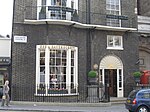 |
| 93 Park Lane | Park Lane W1 | Terraced town house | Samuel Baxter | 1823–5 | 24 Feb 1958 | TQ2806480640 51°30′37″N0°09′22″W / 51.510184°N 0.156°W | 1226023 |  |
| Mercato Mayfair, formerly St Mark's, North Audley Street | North Audley Street W1 | Former church | John Peter Gandy; body of the church remodelled by Arthur Blomfield | 1825–8; 1878 | 24 Feb 1958 | TQ2825380970 51°30′47″N0°09′11″W / 51.513107°N 0.153158°W | 1225301 |  |
| Name | Location | Type | Architect | Completed [note 1] | Date designated | Grid ref. [note 2] Geo-coordinates | Entry number [note 3] | Image |
|---|---|---|---|---|---|---|---|---|
| Paddington Station including the lawn, GWR office block on London Street and offices along Eastbourne Terrace | Eastbourne Terrace W2 | Railway station | Isambard Kingdom Brunel (engineer), Sir Matthew Digby Wyatt (architect), Owen Jones (decoration) | 1851–4 (additions and alterations 1914–6 and 1930s) | 11 Jan 1961 | TQ2655781373 51°31′02″N0°10′39″W / 51.51711°N 0.177441°W | 1066881 |  |
| St Mary Magdalene Church | Rowington Close W2 | Church | George Edmund Street (Crypt Chapel of St Sepulchre by Sir Ninian Comper ) | 1867–78 (Crypt chapel 1895) | 25 Sep 1951 | TQ2573781948 51°31′21″N0°11′21″W / 51.522461°N 0.189048°W | 1235288 |  |
| Name | Location | Type | Architect | Completed [note 1] | Date designated | Grid ref. [note 2] Geo-coordinates | Entry number [note 3] | Image |
|---|---|---|---|---|---|---|---|---|
| St Barnabas Church | St Barnabas St SW1 | Church | Thomas Cundy Jr., assisted by William Butterfield | 1847–50 | 24 Feb 1958 | TQ2841378446 51°29′25″N0°09′06″W / 51.490388°N 0.151772°W | 1265057 |  |
| St James the Less Church | Vauxhall Bridge Road SW1 | Parish church | George Edmund Street | 1859–61 | 24 Feb 1958 | TQ2955478511 51°29′27″N0°08′07″W / 51.490712°N 0.135322°W | 1066164 |  |
| St James the Less Parish Rooms and Schools | Vauxhall Bridge Road SW1 | Village Hall | George Edmund Street; additions by Arthur Edmund Street | 1861; 1890 | 5 Feb 1970 | TQ2958578501 51°29′26″N0°08′06″W / 51.490615°N 0.13488°W | 1066166 |  |
| Name | Location | Type | Architect | Completed [note 1] | Date designated | Grid ref. [note 2] Geo-coordinates | Entry number [note 3] | Image |
|---|---|---|---|---|---|---|---|---|
| 1–6 and 8–14 Park Crescent with 98 Portland Place | Park Crescent and Portland Place W1 | Quadrant of town houses forming eastern half of crescent | John Nash | 1812 | 5 Feb 1970 | TQ2873882062 51°31′22″N0°08′45″W / 51.52281°N 0.145774°W | 1225956 |  |
| 18–26 Park Crescent (including the former No. 27) | Park Crescent and Portland Place W1 | Quadrant of town houses forming western half of crescent | John Nash | 1812 | 5 Feb 1970 | TQ2862782061 51°31′22″N0°08′51″W / 51.522826°N 0.147374°W | 1225959 |  |
| 1–5 York Gate | York Gate NW1 | Terrace | John Nash | c. 1821–2 | 5 Feb 1970 | TQ2828182125 51°31′25″N0°09′08″W / 51.52348°N 0.152335°W | 1225218 |  |
| 8–12 York Gate | York Gate NW1 | Terrace | John Nash | 1821–2 | 5 Feb 1970 | TQ2823582110 51°31′24″N0°09′11″W / 51.523356°N 0.153003°W | 1357372 | 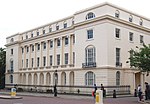 |
| 1–21 Cornwall Terrace | Cornwall Terrace NW1 | Terrace (except Nos. 20 and 21) | Decimus Burton | 1821–3 (restored 1980) | 9 Jan 1970 | TQ2792982181 51°31′27″N0°09′27″W / 51.524063°N 0.157385°W | 1356971 |  |
| Forecourt garden railings to Nos. 20 and 21 | Cornwall Terrace NW1 | Railings | Decimus Burton or John Nash | c. 1821–3 | 1 Dec 1987 | TQ2805282125 51°31′25″N0°09′20″W / 51.523532°N 0.155634°W | 1066947 |  |
| 1–18 York Terrace East, including 6 York Gate | York Terrace East NW1 | Terrace | John Nash | c. 1821–6 | 5 Feb 1970 | TQ2832482180 51°31′26″N0°09′06″W / 51.523964°N 0.151695°W | 1066044 |  Upload Photo |
| Garden railings to park front of Nos. 1–18 | York Terrace East NW1 | Railings | John Nash | c. 1821–6 | 1 Dec 1987 | TQ2831982198 51°31′27″N0°09′06″W / 51.524127°N 0.151761°W | 1225417 |  |
| Doric Villa | 19 and 20 York Terrace East NW1 | Semi-detached villas as one | John Nash | c. 1821–6 | 5 Feb 1970 | TQ2840882205 51°31′27″N0°09′02″W / 51.52417°N 0.150476°W | 1357399 |  |
| Garden railings to park front of Doric Villa | York Terrace East NW1 | Railings | John Nash | c. 1821–6 | 5 Feb 1970 | TQ2840282226 51°31′28″N0°09′02″W / 51.52436°N 0.150555°W | 1225450 |  Upload Photo |
| 1–33 York Terrace West with 7 York Gate | York Terrace West and York Gate NW1 | Terrace | John Nash | c. 1821–6 | 5 Feb 1970 | TQ2816882133 51°31′25″N0°09′14″W / 51.523578°N 0.15396°W | 1066047 |  |
| Garden railings to park front of Nos. 1–33 | York Terrace West NW1 | Railings | John Nash | c. 1821–6 | 1 Dec 1987 | TQ2816382153 51°31′26″N0°09′14″W / 51.523758°N 0.154025°W | 1225553 |  |
| 47 York Terrace West | York Terrace West NW1 | House | John Nash | c. 1821–6 (later rebuilt in facsimile) | 1 Dec 1987 | TQ2807082101 51°31′24″N0°09′19″W / 51.523312°N 0.155383°W | 1066048 |  |
| 1 to 26 Sussex Place, London Graduate School of Business Studies (occupied by London Business School) | 1–26 Sussex Place NW1 | Terrace (rebuilt behind front as business school) | John Nash | 1822–3 | 5 Feb 1970 | TQ2768682410 51°31′34″N0°09′39″W / 51.526176°N 0.160803°W | 1264092 |  |
| Garden railings in front of 1–26 Sussex Place | Sussex Place NW1 | Railings | — | c. 1822–3 | 1 Dec 1987 | TQ2773182434 51°31′35″N0°09′37″W / 51.526381°N 0.160146°W | 1237472 |  |
| 1–20 Hanover Terrace | Hanover Terrace NW1 | Terrace | John Nash | 1822–3 | 14 Jan 1970 | TQ2753682576 51°31′40″N0°09′46″W / 51.527702°N 0.162904°W | 1279085 |  |
| Forecourt garden railings and gate piers to Nos. 1–20 | Hanover Terrace NW1 | Garden railings and gate piers | — | c. 1822–3 | 1 Dec 1987 | TQ2749882644 51°31′42″N0°09′48″W / 51.528321°N 0.163427°W | 1066693 |  Upload Photo |
| Nuffield Lodge | Park Road / Prince Albert Road NW1 | Villa | Decimus Burton | 1822–4 | 5 Feb 1970 | TQ2725082882 51°31′50″N0°10′01″W / 51.530516°N 0.166914°W | 1265526 |  |
| 1–43 Clarence Terrace | Clarence Terrace NW1 | Terrace | Decimus Burton | 1823 (rebuilt 1965) | 9 Jan 1970 | TQ2777682325 51°31′31″N0°09′34″W / 51.525392°N 0.159537°W | 1357311 |  |
| 1–12 Park Square West | Park Square West NW1 | Terrace | John Nash | 1823–5 | 5 Feb 1970 | TQ2854782203 51°31′27″N0°08′55″W / 51.524121°N 0.148474°W | 1265975 |  |
| 14–26 Ulster Place | Ulster Place NW1 | Manor House | John Nash | c. 1824 | 5 Feb 1970 | TQ2854182155 51°31′25″N0°08′55″W / 51.523691°N 0.148578°W | 1066214 | 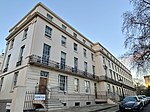 |
| Ulster Terrace | Ulster Terrace NW1 | Terrace | John Nash | c. 1824 | 5 Feb 1970 | TQ2851382248 51°31′28″N0°08′56″W / 51.524533°N 0.148948°W | 1357331 | 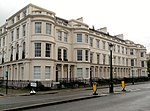 |
| 34 York Terrace West | York Terrace West NW1 | Terraced town house | John Nash | c. 1824–6 | 5 Feb 1970 | TQ2810282109 51°31′24″N0°09′18″W / 51.523377°N 0.154919°W | 1357401 |  Upload Photo |
| Garden railings to park front of Nos. 34–47 | York Terrace West NW1 | Railings | John Nash | c. 1824–6 | 1 Dec 1987 | TQ2808082128 51°31′25″N0°09′19″W / 51.523553°N 0.155229°W | 1225611 |  Upload Photo |
| 35–46 York Terrace West | York Terrace West NW1 | Terrace | John Nash | c. 1824–6 | 5 Feb 1970 | TQ2808682109 51°31′24″N0°09′19″W / 51.52338°N 0.15515°W | 1266293 |  Upload Photo |
| Chimps Breeding Colony, the Gorilla House | London Zoo NW1 | Concrete-framed building | Berthold Lubetkin and the Tecton Group with Ove Arup | 1932–3 | 14 Sep 1970 | TQ2809483571 51°32′11″N0°09′16″W / 51.536517°N 0.154503°W | 1357402 | 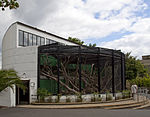 |
| Penguin Pool | London Zoo NW1 | Former penguin pool; now fountain | Berthold Lubetkin and the Tecton Group with Ove Arup | 1934 | 14 Sep 1970 | TQ2817383293 51°32′02″N0°09′12″W / 51.534001°N 0.153466°W | 1225665 |  |
| Name | Location | Type | Architect | Completed [note 1] | Date designated | Grid ref. [note 2] Geo-coordinates | Entry number [note 3] | Image |
|---|---|---|---|---|---|---|---|---|
| Quo Vadis restaurant | 26–28 Dean Street W1 | Terraced houses, now restaurant | John Nolloth(?) | c. 1734 (ground floor altered early 20th century) | 14 Jan 1970 | TQ2967681114 51°30′51″N0°07′57″W / 51.514076°N 0.13261°W | 1290584 |  |
| House of St Barnabas | 1 Greek Street W1 | Corner terrace house | Joseph Pearce | c. 1744–6 | 24 Feb 1958 | TQ2976481213 51°30′54″N0°07′53″W / 51.514946°N 0.131306°W | 1066753 |  |
| National Portrait Gallery | St Martin's Place WC2 | Public art gallery | Ewan Christian and J. K. Colling | 1890–5 | 9 Jan 1970 | TQ2999580611 51°30′34″N0°07′42″W / 51.509483°N 0.128201°W | 1066285 | 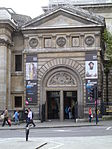 |
| Shaftesbury Memorial Fountain | Piccadilly Circus W1 | Memorial fountain with sculpture | Sir Alfred Gilbert (sculptor) | 1892–3 | 24 Feb 1958 | TQ2955780644 51°30′36″N0°08′04″W / 51.50988°N 0.134497°W | 1265625 |  |
| Name | Location | Type | Completed [note 1] | Date designated | Grid ref. [note 2] Geo-coordinates | Entry number [note 3] | Image |
|---|---|---|---|---|---|---|---|
| Chambers on West side of New Court | Middle Temple | Inns of Court | 1676 | 4 Jan 1950 | TQ3108380996 51°30′46″N0°06′45″W / 51.512691°N 0.112389°W | 1064616 |  |
| Name | Location | Type | Completed [note 1] | Date designated | Grid ref. [note 2] Geo-coordinates | Entry number [note 3] | Image |
|---|---|---|---|---|---|---|---|
| 55 Broadway (including St James's Park tube station) | Westminster | Office building | 1927–1929 | 9 Jan 1970 | TQ2960079486 51°29′58″N0°08′03″W / 51.499463°N 0.134303°W | 1219790 |  |
| Name | Location | Type | Completed [note 1] | Date designated | Grid ref. [note 2] Geo-coordinates | Entry number [note 3] | Image |
|---|---|---|---|---|---|---|---|
| Cleopatra's Needle | Victoria Embankment | Obelisk | 1500 BC | 24 Feb 1958 | TQ3054380516 51°30′31″N0°07′13″W / 51.508503°N 0.120344°W | 1066169 |  |
| York Water Gate | Victoria Embankment | Water gate | 1626 | 24 Feb 1958 | TQ3036480471 51°30′29″N0°07′23″W / 51.50814°N 0.122939°W | 1237938 | 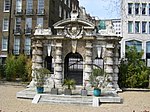 |
| Norman Shaw North Building | Victoria Embankment | Government offices | 1887–90 | 5 Feb 1970 | TQ3028179813 51°30′08″N0°07′28″W / 51.502246°N 0.124377°W | 1274511 |  |
| Name | Location | Type | Completed [note 1] | Date designated | Grid ref. [note 2] Geo-coordinates | Entry number [note 3] | Image |
|---|---|---|---|---|---|---|---|
| Westminster Abbey | Broad Sanctuary SW1 | Abbey | 1050–65 | 24 Feb 1958 | TQ3008279490 51°29′58″N0°07′38″W / 51.499389°N 0.127361°W | 1291494 |  |
| St Margaret's Church | Parliament Square SW1 | Parish church | 11th / 12th century | 24 Feb 1958 | TQ3012479547 51°30′00″N0°07′36″W / 51.499891°N 0.126735°W | 1226286 |  |
| The Great Cloisters of Westminster Abbey, including St Faiths Chapel, the Chapter House, the Parlour, numbers 1 and 2 the Cloisters, the Dark Cloisters and Dormitory with the Chapel of St Dunstan | Abbey Precinct and Westminster School | Manor House | 11th century | 24 Feb 1958 | TQ3007279452 51°29′57″N0°07′39″W / 51.499049°N 0.127519°W | 1066370 |  |
| The Deanery and Sub Dean's Residence with the Jericho Parlour | Abbey Precinct and Westminster School | Building | c. 1370 | 23 Sep 1966 | TQ2999579469 51°29′57″N0°07′43″W / 51.49922°N 0.128621°W | 1066375 | 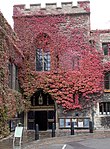 |
| 19, 19a and 20 Broad Sanctuary | Abbey Precinct and Westminster School | Guest House | Late 14th century and 15th century | 24 Feb 1958 | TQ3001479417 51°29′55″N0°07′42″W / 51.498748°N 0.128367°W | 1219626 |  |
| Ashburnham House | Little Dean's Yard SW1 | Town House | Before 1662 | 24 Feb 1958 | TQ3004679409 51°29′55″N0°07′40″W / 51.498669°N 0.127909°W | 1219461 | 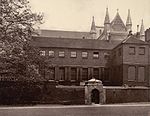 |
| College Dormitory, Westminster School | 4 Little Dean’s Yard SW1 | Manor House | 1722–30 | 9 Jan 1970 | TQ3006879348 51°29′53″N0°07′39″W / 51.498116°N 0.127615°W | 1066372 |  |
| Abbey Precinct Wall | Great College Street SW1 | Gate | Early medieval and c. 1374 with later additions and alterations | 24 Feb 1958 | TQ3014879337 51°29′53″N0°07′35″W / 51.497998°N 0.126467°W | 1357235 |  |
| Clerk of the Works Office and the remains of the Chapel of St Catherine, Little Cloisters Lodgings | Abbey Precinct and Westminster School | Abbey | Late 14th century | 24 Feb 1958 | TQ3010879406 51°29′55″N0°07′37″W / 51.498628°N 0.127018°W | 1357234 |  |
| 18 Dean's Yard | Abbey Precinct and Westminster School | Guest House | 1461 | 24 Feb 1958 | TQ3001479375 51°29′54″N0°07′42″W / 51.498371°N 0.128383°W | 1066406 |  |
| 17 Dean's Yard | Abbey Precinct and Westminster School | Teachers House | Late 18th century | 24 Feb 1958 | TQ3001479357 51°29′54″N0°07′42″W / 51.498209°N 0.128389°W | 1219607 |  |
| Little Deans Yard | Abbey Precinct and Westminster School | Teachers House | 1789–90 | 24 Feb 1958 | TQ3005279357 51°29′54″N0°07′40″W / 51.4982°N 0.127842°W | 1066371 |  |
| Little Deans Yard Staircase to Doorway and Gateway to School and Busby Library | Abbey Precinct and Westminster School | Manor House | 1734 | 9 Jan 1970 | TQ3007079389 51°29′55″N0°07′39″W / 51.498484°N 0.127571°W | 1066373 | 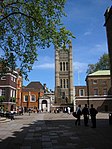 |
| Name | Location | Type | Architect | Completed [note 1] | Date designated | Grid ref. [note 2] Geo-coordinates | Entry number [note 3] | Image |
|---|---|---|---|---|---|---|---|---|
| Queen Mary's Steps and fragment of Whitehall Palace | Horse Guards Avenue SW1 | Part of former riverside terrace and steps and remains of palace wall | Sir Christopher Wren (steps) | Tudor and 1691–3 | 14 Jan 1970 | TQ3029780072 51°30′16″N0°07′27″W / 51.504569°N 0.124051°W | 1066636 |  |
| Ministry of Defence Main Building | Horse Guards Avenue SW1 | Government offices incorporating Tudor palace undercroft and historic rooms from the site | Sir William Chambers (rooms from Pembroke House); Vincent Harris (government offices) | c. 1530 (undercroft of York Place, later Whitehall Palace); c. 1757, 1760 and 1773 (rooms from Pembroke House); c. 1722 (room from Cromwell House) | 14 Jan 1970 | TQ3024080010 51°30′14″N0°07′30″W / 51.504025°N 0.124894°W | 1278223 |  |
| Treasury Buildings | Whitehall SW1 | Government offices with remains of former palace | William Kent, Sir John Soane and Sir Charles Barry | c. 1530 (remains of Whitehall Palace); c. 1700–10/11 (Dover House); 1733–6 (Kent's "new" Treasury); 1824–7 (Privy Council and Cabinet Offices; these remodelled 1845–7 and 1960–4) | 5 Feb 1970 | TQ3012079956 51°30′13″N0°07′36″W / 51.503568°N 0.126642°W | 1267063 |  |
| Banqueting House | Whitehall SW1 | Former banqueting house of Whitehall Palace | Inigo Jones (refaced by Sir John Soane; altered by James Wyatt ) | 1619–25 | 1 Dec 1987 | TQ3016680069 51°30′16″N0°07′33″W / 51.504573°N 0.125938°W | 1357353 |  |
| 10 Downing Street | Downing Street SW1 | Large terraced town house | Office of Works (Kent, I. Ware and H. Flitcroft probably all involved); K. Couse (street front); R. Erith and Q. Terry (20th-century reconstruction and interiors) | c. 1677 (older house incorporated into Downing's development of 1682); alterations 1723–35; street front replaced c. 1766–75; reconstructed 1960–4; Terry's work 1988–90 | 14 Jan 1970 | TQ3005979937 51°30′12″N0°07′39″W / 51.503411°N 0.127528°W | 1210759 | 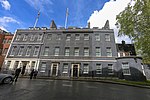 |
| 11 Downing Street | Downing Street SW1 | Terraced town house | Kenton Couse (street front); Raymond Erith (reconstruction) | 1682; altered c. 1723–5, refaced c. 1766–75, altered again early 19th century, reconstructed 1960–4 | 14 Jan 1970 | TQ3003579935 51°30′12″N0°07′40″W / 51.503399°N 0.127874°W | 1356989 |  |
| The Admiralty and the Admiralty Screen | Whitehall SW1 | Government offices | Thomas Ripley; screen by Robert Adam | 1723–6; screen 1759–61 | 5 Feb 1970 | TQ3003880202 51°30′21″N0°07′40″W / 51.505797°N 0.127732°W | 1066099 |  |
| Horse Guards | Whitehall SW1 | Former army offices, now a museum | William Kent | c. 1745–8 | 5 Feb 1970 | TQ3007480089 51°30′17″N0°07′38″W / 51.504773°N 0.127256°W | 1066100 | 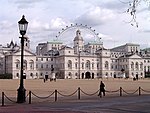 |
| Forecourt railings, gates and guardhouses to Horse Guards | Whitehall SW1 | Railings, gates and guardshouses | — | c. 1750–60 | 5 Feb 1970 | TQ3010680104 51°30′18″N0°07′36″W / 51.504901°N 0.126789°W | 1267077 |  |
| Dover House (Scotland Office) | Whitehall SW1 | Former mansion, now government offices | James Paine (rear) and Henry Holland (front) | 1755–8; enlarged 1787 | 5 Feb 1970 | TQ3009380028 51°30′15″N0°07′37″W / 51.504221°N 0.127004°W | 1066101 | 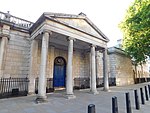 |
| Admiralty House | Whitehall SW1 | Former official residence of the First Lord of the Admiralty | Samuel Pepys Cockerell | 1786–88 | 5 Feb 1970 | TQ3006680172 51°30′20″N0°07′38″W / 51.505521°N 0.12734°W | 1267114 | 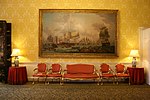 |
| Foreign and Commonwealth Office | Whitehall SW1 | Government offices | Sir George Gilbert Scott with Sir Matthew Digby Wyatt | 1861–73 | 5 Feb 1970 | TQ2999679871 51°30′10″N0°07′42″W / 51.502832°N 0.128459°W | 1066102 |  |
| The Cenotaph | Parliament Street SW1 | War memorial | Sir Edwin Lutyens | 1919–20 | 5 Feb 1970 | TQ3015979858 51°30′10″N0°07′34″W / 51.502678°N 0.126117°W | 1357354 |  |
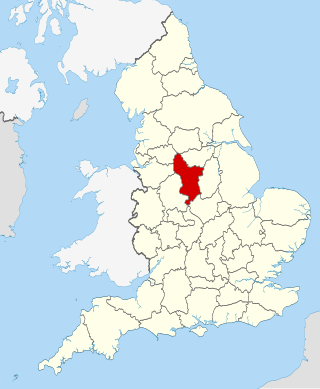
There are over 9000 Grade I listed buildings in England. This page is a list of these buildings in the county of Derbyshire, sub-divided by district.
There are 67 Grade I listed buildings in Cambridge, England. In the United Kingdom, a listed building is a building or structure of special historical or architectural importance. These buildings are legally protected from demolition, as well as from any extensions or alterations that would adversely affect the building's character or destroy historic features. Listed buildings in England are divided into three categories—Grade II buildings are buildings of special interest; Grade II* buildings are Grade II buildings of particular interest; and Grade I buildings, which are those of "exceptional" interest. Only around two per cent of listed buildings are given Grade I status.
There are 47 Grade II* listed buildings in Cambridge, England. In the United Kingdom, a listed building is a building or structure of special historical or architectural importance. These buildings are legally protected from demolition, as well as from any extensions or alterations that would adversely affect the building's character or destroy historic features. Listed buildings in England are divided into three categories—Grade II buildings are buildings of special interest; Grade II* buildings are buildings of particular importance; and Grade I buildings, which are those of "exceptional" interest. Around four per cent of listed buildings are given Grade II* status.
There are over 20,000 Grade II* listed buildings in England. This page is a list of these buildings in the district of Dartford in Kent.
There are over 20,000 Grade II* listed buildings in England. This page is a list of these buildings in the district of Dover in Kent.
There are over 20,000 Grade II* listed buildings in England. This page is a list of these buildings in the district of East Cambridgeshire in Cambridgeshire.
There are over 20,000 Grade II* listed buildings in England. This page is a list of these buildings in the metropolitan borough of Bradford in West Yorkshire.
There are over 9,000 Grade I listed buildings in England. This page is a list of these buildings in the district of Dartford in Kent.
There are over 9,000 Grade I listed buildings in England. This page is a list of these buildings in the district of Dover in Kent.
There are over 20,000 Grade II* listed buildings in England. This page is a list of these buildings in the City of Carlisle in Cumbria.
There are over 20,000 Grade II* listed buildings in England. This page is a list of these buildings in the district of Copeland in Cumbria.
There are over 20,000 Grade II* listed buildings in England. This page is a list of these buildings in the City of Chelmsford in Essex.
There are over 9,000 Grade I listed buildings in England. This page is a list of these buildings in the City of London.
There are over 20,000 Grade II* listed buildings in England. This page is a list of these buildings in the City of London.
There are over 20,000 Grade II* listed buildings in England. This page is a list of these buildings in the district of Craven in North Yorkshire.
There are over 20,000 Grade II* listed buildings in England. This page is a list of these buildings in the district of the City of York in North Yorkshire.

Stoke-on-Trent is a city located in Staffordshire, England. The city is a linear conurbation of six constituent towns. Stoke-on-Trent is considered to be the home of the pottery industry in England and is commonly known as the Potteries. Formerly a primarily industrial conurbation, it is now a centre for service industries and distribution centres.
There are over 9,000 Grade I listed buildings in England. This page is a list of these buildings in the City of York in North Yorkshire.
There are over 20,000 Grade II* listed buildings in England. This page is a list of these buildings in the City of Westminster.
There are over 20,000 Grade II* listed buildings in England. This page is a list of these buildings in the City of Westminster.